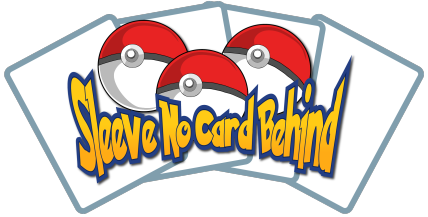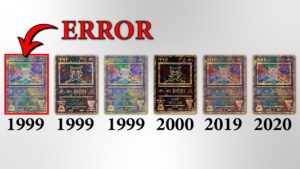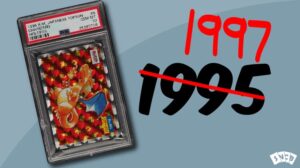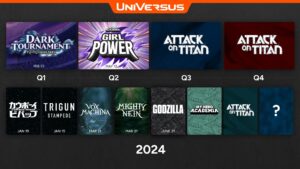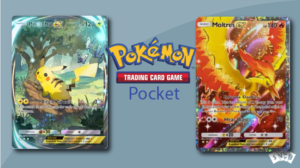How to Spot Fake Pokémon Cards (Fast!)
-
By: Oliver Copeland
- Published:
- Last Updated: December 2, 2023
When I was collecting Pokémon cards as a kid, I knew about fakes but didn’t know how to spot them. 25 years later, I’m now an expert at spotting fake cards.
Truthfully, most fakes are really poorly made. They only need to fool parents, grandparents, and kids.
In this article, I aim to go over every aspect and take a deep dive into fake Pokémon cards. Keep reading and become an expert at spotting fake Pokémon cards.
What are fake cards and why are they made?
Fake cards are made to make money. It’s that simple.
The folks who print fake cards prey on uninformed customers (usually parents purchasing them for their kids). With retail store shelves empty and scalper prices over-inflated online, people turn to third-party sites where they discover Pokémon cards for a ridiculously cheap price.
I know what you’re thinking: Isn’t it obvious though? To you and me, yes. But to a parent or grandparent who has never taken the time to hold a card and look at it, maybe learn about it, no.
These fakes are often made in China and are found on websites such as aliexpress.com or amazon.com (yes, Amazon). The good news is that these fakes are easy to tell apart from real copies, so most of the time people get burned for $20 and learn their lesson.
However, there are fakes out there that are nearly identical to the originals and only a keen eye can tell them apart. We’ll get to these soon.
Fake booster packs and booster boxes
But it can’t be fake, I pulled it straight from a pack!
- Everyone
There are fake packs. There are fake booster boxes, too. Most booster packs can be identified very quickly simply by checking the cut of the crimped ends. For more info on fake booster packs, we have a whole article to check out. How to Spot Fake Booster Packs.

The Most Common Fakes
- Incorrect name
- Typos
- Poor grammar
- Incorrect holo pattern
- Incorrect font
- Crazy stats or high HP (like 10,000 HP)
A common fake is a card that, at first, will be perceived as real. These cards will have minor tells such as an incorrect holo pattern, unique font, spelling errors, or other small details. However, they won’t fool the average Pokémon card hobbyist.
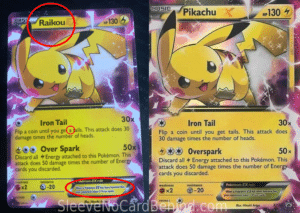
Here is a fake Pikachu EX card (left) compared to the authentic copy (right).
We’ve circled three critical errors on the fake card. As you can see, the Pokémon’s name is incorrect, there is a grammatical error in the attack description, and the rule box on the lower right is missing the background effect. In addition to these, there are multiple more errors on the card.
It is, however, not a bad fake. The biggest tell is the incorrect name of the Pokémon. Other than that, the card could be passed off as authentic at a glance. These types of fakes often make their way into children’s collections, as they do not yet know how to look for smaller details such as typos and grammatical errors.
Another quick tell for fake cards is the holo pattern or etching of the card. This Pikachu example doesn’t demonstrate this so well, so let’s take a look at these Lapras.
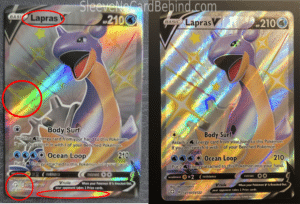
A fake Lapres V (left) compared to the authentic copy (right).
“Lapras” is not outlined in white, the star graphic is dim, the copyright is in the wrong position, and it does not include “Pokémon/ Nintendo/ Creatures/ GAME FREAK”.
You can probably spot a few more errors on the fake card. The authentic Lapras V is an etched card. Etching is a texture that you can feel with your thumb or finger. The fake does not have any etching.
Fakes with etching
Only recently have fakes with etching come into production. It’s unfortunate that this feature is being reproduced by the fakers, but simply spreading awareness is the first step to fighting back.
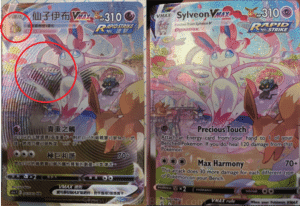
The etching on the fake Sylveon VMAX is not consistent with the authentic copy. When authentic cards have etching, it is usually very precise and detailed. As you can see, the fake copy has one pattern repeated throughout the card, and the etching is much larger and less intricate. However, most fakes do not have etching, so this could fool someone as long as they don’t notice the obvious glaring issue in the top left…
Good fakes
Good fakes may fool a casual collector.
Over the years, Pokémon cards have become more and more intricate and detailed. The etching of a card is just one example of a detail that makes reproduction difficult for bootleg manufacturers. But older cards, specifically the Wizards of the Coast era, are simple in terms of card design and can be more easily faked.
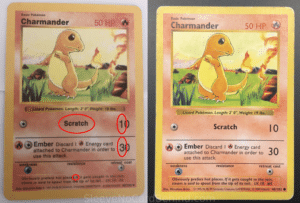
A Charmander (left) compared to the authentic copy (right). Note: Brightness and clarity are due to the photo taken, and do not accurately represent the actual card.
As you can see, the font is the quickest way to determine if this Charmander card is a fake.
Expert-level fakes
An expert-level fake can fool an expert. One recent example we have here is a card that isn’t entirely fake, and that’s what is so deceiving about it.
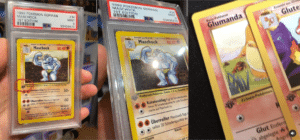
Butticards on Instagram has done something very interesting. As an experiment, they printed 1st edition stamps onto non-first edition cards using a UV printer, and as you can see, they look nearly indistinguishable from authentic stamps.
Next, they sent one of the cards into PSA, expecting it to be rejected. However, it was graded and authenticated. PSA did reach out to butticards on their Instagram, and if you look up the slab number, the submission has been deactivated.
Butticards did not invent this method either, they’d heard about it elsewhere and decided to give it a try. It is honorable that they posted this to Instagram, to bring it to light. But the question is, how many fake 1st edition cards are already out there?
Conclusion
Pokémon is the biggest media franchise in the world. As cards continue to grow in popularity, fakes will continue to be produced. It’s important to stay on top of the hobby and know what to look for. It’s also important to share knowledge with your friends and community, to mitigate the purchasing of fake cards.
